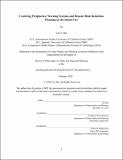| dc.contributor.advisor | James Wescoat. | en_US |
| dc.contributor.author | Bui, Lily,1987- | en_US |
| dc.contributor.other | Massachusetts Institute of Technology. Department of Urban Studies and Planning. | en_US |
| dc.date.accessioned | 2021-02-19T20:42:33Z | |
| dc.date.available | 2021-02-19T20:42:33Z | |
| dc.date.copyright | 2020 | en_US |
| dc.date.issued | 2020 | en_US |
| dc.identifier.uri | https://hdl.handle.net/1721.1/129892 | |
| dc.description | Thesis: Ph. D., Massachusetts Institute of Technology, Department of Urban Studies and Planning, September, 2020 | en_US |
| dc.description | Cataloged from student-submitted PDF of thesis. | en_US |
| dc.description | Includes bibliographical references (pages 205-226). | en_US |
| dc.description.abstract | Warning systems play a crucial role in disaster events on islands. They enable timely communication of risk, bolstering capacity and counterbalancing the negative force exerted by hazards, exposures, and vulnerabilities that threaten island communities. Disasters frequently result in the breakdown of communication due to both structural (i.e., power outages, failed telecommunications equipment, aging infrastructure) and nonstructural issues (i.e., governance, socioeconomic inequity, language barriers). Through semi-structured interviews, participant observation, document review and spatial data visualization, this dissertation compares the hurricane warning systems of two U.S. island cities: San Juan, Puerto Rico, and Honolulu, O'ahu, Hawaii, during Hurricane Maria (2017) and Hurricane Lane (2018), respectively. The research questions are as follows: -- Under what conditions are warning systems successful or unsuccessful in island cities? -- | en_US |
| dc.description.abstract | What gaps in capacity can be observed in island city warning systems? -- | en_US |
| dc.description.abstract | How do these gaps affect disaster planning in the island context? This dissertation proposes a conceptual framework for evaluating warning systems that takes into consideration the temporal aspects of warning. The framework illustrates the ways in which warning and planning are interrelated, as well as how planning and warning processes take place over time. The dissertation argues that good planning is good warning, and good warning is shaped by good planning. It finds that short-term warning (i.e. forecasting) is usually able to achieve its goals successfully whereas long-term warning (i.e. planning around preparedness, generational knowledge and culture, myths and history, and recovery) is prone to various capacity gaps across the two cases. The most significant finding is that O'ahu and Puerto Rico's planning and warning capacity grew after Hurricanes Lane and Maria, but the gap in capacity between both islands still remains noteworthy. | en_US |
| dc.description.abstract | Ultimately, the planning gaps between both islands point toward other possible differential capacities for planning and warning on other U.S. islands. | en_US |
| dc.description.statementofresponsibility | by Lily D. Bui. | en_US |
| dc.format.extent | 243 pages | en_US |
| dc.language.iso | eng | en_US |
| dc.publisher | Massachusetts Institute of Technology | en_US |
| dc.rights | MIT theses may be protected by copyright. Please reuse MIT thesis content according to the MIT Libraries Permissions Policy, which is available through the URL provided. | en_US |
| dc.rights.uri | http://dspace.mit.edu/handle/1721.1/7582 | en_US |
| dc.subject | Urban Studies and Planning. | en_US |
| dc.title | Centering peripheries : warning systems and disaster risk reduction planning on the island city | en_US |
| dc.title.alternative | Warning systems and disaster risk reduction planning on the island city | en_US |
| dc.type | Thesis | en_US |
| dc.description.degree | Ph. D. | en_US |
| dc.contributor.department | Massachusetts Institute of Technology. Department of Urban Studies and Planning | en_US |
| dc.identifier.oclc | 1237276328 | en_US |
| dc.description.collection | Ph.D. Massachusetts Institute of Technology, Department of Urban Studies and Planning | en_US |
| dspace.imported | 2021-02-19T20:42:03Z | en_US |
| mit.thesis.degree | Doctoral | en_US |
| mit.thesis.department | UrbStud | en_US |
